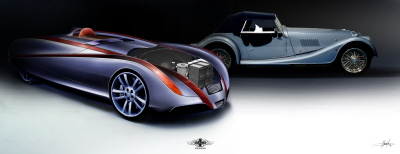renewable energy > newsfile > first fuel cell sports car on the way
First fuel cell sports car on the way
Posted: 23 Sep 2005
A wholly British partnership has unveiled plans to develop the world's first environmentally clean sports car, powered by a fuel cell which converts hydrogen into electricity.
The partnership is made up of famous Morgan sports car manufacturer, with a history going back 100 years, QinetiQ, Cranfield and Oxford Universities, BOC and OSCar.
The new vehicle, known as LIFECar, will be ultra quiet and its exhaust systems will produce only water vapour. It promises a clean vehicle
combined with sound motoring performance and stylish good looks.
 |
|
Morgan sports cars: then and now
|
Part-funded by the Department for Trade and Industry (DTI), LIFECar is a two and half-year long project. The development team say it marks a step change in vehicle power technology, that will produce a combination of performance, range and fuel economy that will be essential to its success.
Four motors
LIFECar will be based on the Morgan Aero Eight, and is powered by a QinetiQ-made fuel cell, which converts hydrogen - and oxygen taken from the air around it - into electrical energy. It will be clean, quiet and economic, and the only waste product from the car will be water.
The car's power system aims to be extremely efficient, producing significant improvements over current fuel cell prototype vehicles, with the fuel cell powering four separate electric motors, one at each drive wheel.
 |
|
The Morgan fuel cell LIFECar
|
The key to delivering this step change in energy efficiency lies in a combination of factors, including weight reduction and a different design
approach. This exploits opportunities across the vehicle to reduce energy losses and requirements.
Regenerative braking and surplus energy will be used to charge ultra-capacitors, which will release their energy when the car is
accelerating. This will allow the car to have a much smaller fuel cell than is conventionally regarded as necessary: it will only be as
large as is required to provide cruising speed, approximately 24 kW, as opposed to around 85kW proposed by most competitor systems.
Speaking at this year's Society of Motor Manufacturers International Business Group, where the plans were unveiled, Charles Morgan, corporate strategy director of the Morgan Motor Company, director, said that "LIFECar promises to combine advanced technology while retaining the best in traditional ways of designing and building cars. A sports car that is beautiful, brilliant to drive but pollution free must be a goal worth striving for".
Energy revolution
Ian Whiting, business development manager, QinetiQ said: "LIFECar is about catching the first big wave in the energy revolution, which is set to transform the motoring industry in the same way that the computer industry was transformed by the personal computer decades ago."
Costing a total of £1.9m, with a mix of industry and DTI funding, the two and half year project will be broken down into the following areas of
responsibility with BOC developing the hydrogen refuelling plant and Cranfield University working on the on-board computing and control of the fuel-cell hybrid powertrain.
The Morgan Motor Company will provide the car platform and assemble the final concept car.Oxford University is undertaking the design and control of the electric motors and OSCar is responsible for overall system design and architecture. QinetiQ is developing the Proton Exchange Membrane Fuel Cell.
|

